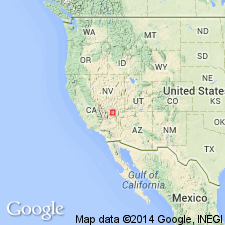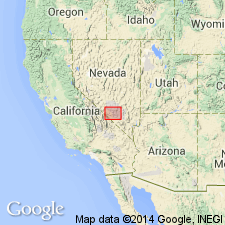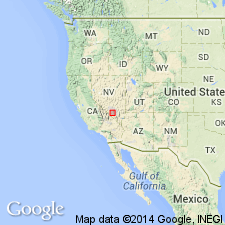
- Usage in publication:
-
- Pah Canyon Member*
- Modifications:
-
- Named
- Dominant lithology:
-
- Tuff
- AAPG geologic province:
-
- Great Basin province
Summary:
Named as a member (1 of 5) of Paintbrush Tuff of Piapi Canyon Group for exposures in Pah Canyon--its type section--in the west-central part of the Nevada Test Site, Nye Co, NV in the Great Basin province. Overlies and underlies bedded tuff (unnamed) of the Paintbrush. Is 250 ft thick at type; Maximum thickness is 300 ft at Yucca Mountain to southwest. Generally ranges between 40 and 180 ft thick. Is a simple cooling unit of rhyolitic ash-flow tuff that is light-gray to -brown, partly to densely welded, devitrified, containing 5-15 percent phenocrysts of biotite, alkali feldspar, and plagioclase. Quartz and clinopyroxene are rare as phenocrysts. Characterized by abundant small pumice, and by felsic lithic inclusions, and abundant biotite. Recognized in west and north area of Test Site, and in Frenchman Flat and Yucca Mountain areas. Cross section. Nomenclature chart. Of Miocene? and Pliocene age.
Source: GNU records (USGS DDS-6; Denver GNULEX).

- Usage in publication:
-
- Pah Canyon Member*
- Modifications:
-
- Areal extent
- Overview
- AAPG geologic province:
-
- Great Basin province
Summary:
Is one of the four named members of the Paintbrush Tuff. Distribution map; present around northeast and south sides of the Timber Mountain caldera, southern Nye Co, NV in the Great Basin province. Was erupted from the Claim Canyon cauldron. Stratigraphic chart. Is underlain and overlain by unnamed bedded tuff of the Paintbrush. Is a simple ash-flow cooling unit without compositional zoning. Silica content of 74 percent. Has flattened pumice lenticles less than 2 cm long. Sparse to common small cognate inclusions, mostly less than 0.5 cm distributed throughout member. The extracauldron extent is about 200 sq km. Extracauldron volume does not exceed 20 cubic km. Is 90 m thick at cauldron rim and 200+ m in cauldron segment. Has a Pliocene age. Modal analyses.
Source: GNU records (USGS DDS-6; Denver GNULEX).

- Usage in publication:
-
- Pah Canyon Tuff*
- Modifications:
-
- Revised
- AAPG geologic province:
-
- Great Basin province
Summary:
Within southwest Nevada volcanic field, Nye Co, NV, Great Basin province, units previously of formation rank are raised to group rank to allow for combining petrographically, geochemically, and temporally related lava flows and nonwelded tuffs with the principal correlative welded ash-flow tuff sheets (formerly members of the previous formation-rank tuffs). The ash-flow sheets are raised to formation rank and designated as "Tuff." Pah Canyon is one of four formal formation-rank units of Paintbrush Group (rank raised). [Paintbrush also consists of informal units not discussed in this report.] Younger than Topopah Spring Tuff (rank raised) of Paintbrush; older than Yucca Mountain Tuff (rank raised) of Paintbrush. Nomenclature shown on table 1. Miocene age.
Source: GNU records (USGS DDS-6; Denver GNULEX).
For more information, please contact Nancy Stamm, Geologic Names Committee Secretary.
Asterisk (*) indicates published by U.S. Geological Survey authors.
"No current usage" (†) implies that a name has been abandoned or has fallen into disuse. Former usage and, if known, replacement name given in parentheses ( ).
Slash (/) indicates name conflicts with nomenclatural guidelines (CSN, 1933; ACSN, 1961, 1970; NACSN, 1983, 2005, 2021). May be explained within brackets ([ ]).

